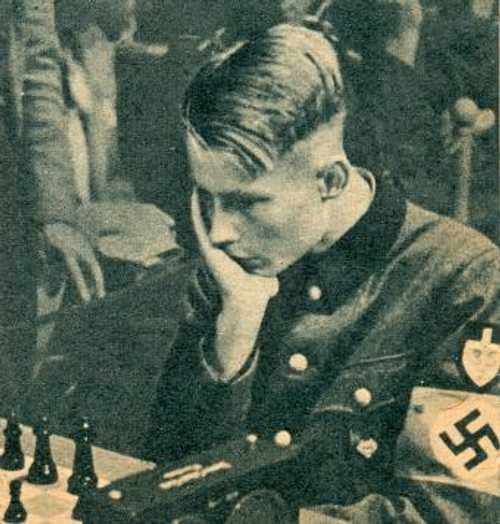
Homefront
Chess Master Race
Chess was hardly the most vital interest for the upper ranks in Nazi Germany (unless of course one counts Generalfeldmarschall von Manstein), but that sedate old intellectual game was not totally ignored in the all-encompassing National Socialist Revolution. Shortly after Hitler's accession to power, the German Chess Federation was reconstituted in an "Aryanised" form as the "Grossdeutsche Schachbund". The position of President had to be filled by someone approved by Hitler; not surprisingly, Dr Goebbels became President. Jews (with the exception of certain WW1 veterans) were banned from membership of chess clubs in Germany, a move that connected naturally with the withdrawal of Germany from the International Chess Federation (FIDE). Another chess "Great Power" of the period, the Soviet Union, also stood outside FIDE, although both had representative status. That was the case at least up to the outbreak of WW2, following which Germany set up its own "International Chess Association" which, presumably, was to provide an "Aryanised" substitute for FIDE once the war was won. With the outbreak of war, chess in Germany and the occupied countries decended into a sort of half-life, with its own programme of tournaments in which, as well as Germans, citizens of occupied countries (including the Soviet Union) who could be "influenced" in various ways by the Nazi authorities competed on a pretty regular basis until close to the war's end. The young man in the photograph is Klaus Junge, a Chilean-born German, son of Chilean-German Otto Junge who had held the Chilean Chess Championship. The Junge family had moved back to Germany from Chile in 1928, when Klaus was four years old. Otto was a convinced National Socialist, who joined the Party in 1932; he appears to have passed his convictions on to his five sons. By 1942, when this photo (in Labour Front uniform) was taken, Klaus Junge had emerged as one of Germany's youngest Chess Masters, and was considered one of the most promising - indeed, one of the best - players in the German/Occupied chess goldfish bowl. This achievement should not be under-estimated; that goldfish bowl contained some very big fish. The highlight of his career probably came in 1942, a year in which he came close to winning a number of major tournaments, tying for first place in one. A particular highlight was his games against Alexander Alekhine, one of the true giants of 20th century chess who had, in effect, fallen into the Nazi's clutches throught blackmail. Alekhine had held the pre-war World Chess Championship for two periods of years and was, obviously, a great deal more experienced than the 18-year old Klaus. Klaus played Alekhine in four 1942 tournaments (Salzburg, Lublin, Prague and Munich), in which he was twice defeated, scored one victory, and played out one draw - an enormously creditable achievement. I have "played through" these games (I am a rubbish player, but can follow the game). They suggest that Klaus had the potential to follow in Alekhine's footsteps; his play is characterised by a combination of clear strategic thought, aggression and flexibility - sometimes a bit too much aggression. Time would surely have cured that fault. Regrettably, Klaus Junge would not get the opportunity to develop a mature talent in a more peaceful world. A Heer Leutnant, he was killed in action on the Luneburg Heath, 17 April, 1945, about three weeks before the end of the war. Best regards, JR.
3394 Views
12/30/2009
